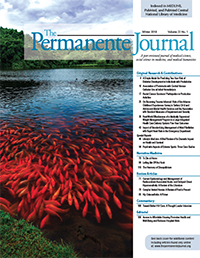Kaiser Permanente's report in NEJM AI details insights from a large-scale rollout of ambient AI clinical documentation technology.
Winter Edition of the Permanente Journal Now Available
 The latest Permanente Journal is now available for download, and includes a variety of peer-reviewed articles and studies on topics from hip osteoarthritis to standardizing management of atrial fibrillation. This edition also includes a study looking at the benefits of prevention-based lifestyle medicine co-written by Dawn Clark, MD, chief physician wellness officer of the Southern California Permanente Medical Group; and excerpts of an interview on HIV care at the Veterans Administration and Kaiser Permanente, including comments from Michael Horberg, MD, national director of HIV/AIDS care at Kaiser Permanente.
The latest Permanente Journal is now available for download, and includes a variety of peer-reviewed articles and studies on topics from hip osteoarthritis to standardizing management of atrial fibrillation. This edition also includes a study looking at the benefits of prevention-based lifestyle medicine co-written by Dawn Clark, MD, chief physician wellness officer of the Southern California Permanente Medical Group; and excerpts of an interview on HIV care at the Veterans Administration and Kaiser Permanente, including comments from Michael Horberg, MD, national director of HIV/AIDS care at Kaiser Permanente.
Read more about what’s inside this quarter’s Journal and click on articles of interest below. Or you can download the PDF for the complete edition.
Original Research and Contributions
A Simple Model for Predicting Two-Year Risk of Diabetes Development in Individuals with Prediabetes
Harry Glauber, MD; William M Vollmer, PhD; Gregory A Nichols, PhD
On the basis of an observational study of 77,000 adult Kaiser Permanente members with prediabetes, and using hemoglobin A1C and body mass index, the authors created a simple stratification scheme to more precisely estimate risk of type 2 diabetes incidence. This will enable more efficient assignment of prevention interventions and clinical and laboratory follow-up to the small subset at highest risk (5.2 percent), while minimizing the potentially negative effects of overdiagnosis among the majority with prediabetes.
Association of Proteinuria with Central Venous Catheter Use at Initial Hemodialysis
Ken J Park, MD; Ning Smith, PHD; Ning Smith, PHD; David M Mosen, PHD; Micah L Thorp DO, MPH
Central venous catheter (CVC) use is associated with increased mortality and complications in hemodialysis recipients. In a retrospective cohort of 918 Kaiser Permanente Northwest hemodialysis recipients, 36 percent of patients started hemodialysis with an arteriovenous fistula, and 64 percent started with a CVC. Proteinuria was associated with use of CVC; however a graded association did not exist, and only patients with midgrade proteinuria had significantly lower odds of CVC use. Proteinuria is an explanatory finding for CVC use but may not have pragmatic value for decision making.
Rectal Cancer Survivors’ Participation in Productive Activities
Mark C Hornbrook, PhD; Marcia Grant, RN, PhD, FAAN; Christopher Wendel, MS; Joanna E Bulkley, PhD; Carmit K McMullen, PhD; Andrea Altschuler, PhD; Larissa KF Temple, MD, MSc, FACS, FRCS(C); Lisa J Herrinton, PhD; Robert S Krouse, MD, FACS
Of 1,063 Kaiser Permanente rectal cancer survivors, 577 responded to a mailed questionnaire. Staying productive is associated with better mental health. Responses indicated that survivors with multiple chronic conditions, higher disease stage, lower productive activities, and older age need better access to medical care and closer monitoring of the quality of their care, including self-care. To better capture the involvement of survivors, research should routinely include measures of employment, searching for employment, homemaking, and volunteering.
On Becoming Trauma-Informed: Role of the Adverse Childhood Experiences Survey in Tertiary Child and Adolescent Mental Health Services and the Association with Standard Measures of Impairment and Severity
Abdul Rahman, MD, FRCPC; Andrea Perri, MSN; Avril Deegan, MSW; Jennifer Kuntz, MSW; David Cawthorpe, MSc, PhD
To examine the clinical utility of the Adverse Childhood Experiences (ACE) survey as an index of trauma in a child and adolescent mental health care setting, descriptive, polychoric factor, and regression analyses were employed with cross-sectional ACE surveys (2,833) and registration-linked data using past admissions (10,400) from November 2016 to March 2017 related to clinical data. There was substantial ACE total score variance for females (44 percent) and males (38 percent). Implications include that a child presenting with anxiety and a high ACE score likely requires treatment that is different from a child presenting with anxiety and an ACE score of zero.
![]() Real-World Effectiveness of a Medically Supervised Weight Management Program in a Large Integrated Health Care Delivery System: Five-Year Outcomes
Real-World Effectiveness of a Medically Supervised Weight Management Program in a Large Integrated Health Care Delivery System: Five-Year Outcomes
Ashok Krishnaswami, MD, MAS; Rohini Ashok, MD; Stephen Sidney, MD, MPH; Michael Okimura, MD; Beth Kramer, MBA; Lindsay Hogan, MHSA; Michael Sorel, MPH; Sheri Pruitt, PhD; Wayne Smith, MD
There are insufficient data on the long-term, nonsurgical, nonpharmacologic treatment of obesity. In a retrospective observational study of 10,693 participants, 2,777 were available for analysis at 5 years. The average age was 51.1 years, 72.8 percent were women, and average baseline weight was 112.9 kg. In those with 5-year follow-up: weight loss between 5 percent and 9.9 percent below baseline occurred in 16.3 percent, and weight loss of 10 percent or more of baseline occurred in 35.2 percent. All changes were statistically significant.
![]() Impact of Standardizing Management of Atrial Fibrillation with Rapid Heart Rate in the Emergency Department
Impact of Standardizing Management of Atrial Fibrillation with Rapid Heart Rate in the Emergency Department
Ernesto de Leon, MD; Lewei Duan, MS; Ellen Rippenberger, MPH; Adam L Sharp, MD, MS
There is substantial variation in the emergency treatment of atrial fibrillation with tachycardia. The standardized treatment guideline (applied in a community Emergency Department [ED]) encouraged early oral treatment with rate control medication, outpatient echocardiogram, and early follow-up. A total of 199 (104 pre/95 post) ED encounters (August 2013 to June 2014) were evaluated. The ED discharge rate increased 14 percent after intervention, and use of rate-control medications increased by 19.4 percent, with a two-fold likelihood of ED discharge after guideline use.
![]() Impact of Asynchronous Training on Radiology Learning Curve among Emergency Medicine Residents and Clerkship Students
Impact of Asynchronous Training on Radiology Learning Curve among Emergency Medicine Residents and Clerkship Students
Ali Pourmand, MD, MPH, RDMS; Christina Woodward, MD; Hamid Shokoohi, MD, MPH, RDMS;Jordan B King, PharmD, MS; M Reza Taheri, MD, PhD; Jackson King; Christopher Lawrence
A total of 131 Emergency Medicine clerkship students and 32 Emergency Medicine residents were enrolled in a web-based learning module. There was a significant improvement in percentage of correctly classified computed tomography images after the training intervention. Among subsets by training level, all subgroups, except first-year residents, demonstrated a statistically significant increase in scores after the training.
Julia E Rawlings, PharmD; Sheryl J Herner, PharmD, MHSA;Thomas Delate, PhD, MS; Kelsey E Palmer, PharmD;Kelly A Swartzendruber, PharmD
This survey was conducted online in an ambulatory Pharmacy Department; 429 of 900 staff participated in an integrated health care delivery system. Although health care system personnel may prefer to measure patient safety culture with a survey instrument that assesses a variety of workplace environment measures, these findings suggest that use of nonvalidated work environment indices will not provide accurate assessment of patient safety culture
in a Pharmacy Department.
in a Pharmacy Department.
![]() A Randomized Controlled Trial of Financial Incentives for Medicaid Beneficiaries with Diabetes
A Randomized Controlled Trial of Financial Incentives for Medicaid Beneficiaries with Diabetes
Ritabelle Fernandes, MD, MPH; Chuan C Chinn, PhD; Dongmei Li, PhD; Timothy B Frankland, MA; Christina MB Wang, MPH, RN; Myra D Smith, MPH; Rebecca Rude Ozaki, PhD
This study was conducted at Kaiser Permanente Hawaii with 320 participants (159 intervention group/161 control group). Participants could earn up to $320/y in financial incentives. Evaluation measures included 1) clinical outcomes of change in hemoglobin A1C, blood pressure, and cholesterol; 2) compliance with American Diabetes Association standards; 3) cost-effectiveness; 4) quality of life; 5) self-management activities; and 6) satisfaction with incentives. Overall, this study found no conclusive evidence that financial incentives alone had beneficial effects on improving standards of medical care in diabetes.
Special Reports
![]() Lifestyle Medicine: A Brief Review of Its Dramatic Impact on Health and Survival
Lifestyle Medicine: A Brief Review of Its Dramatic Impact on Health and Survival
Balazs I Bodai, MD, FACS; Therese E Nakata, STAR Provider, CWFPBN; William T Wong, MD; Dawn R Clark, MD, FACOG; Steven Lawenda, MD, ABFM; Christine Tsou, MD; Raymond Liu, MD; Linda Shiue, MD; Neil Cooper, MD; Michael Rehbein, MD, FACP; Benjamin P Ha, MD, ABFM; Anne McKeirnan, MD, FACOG; Rajiv Misquitta, MD; Pankaj Vij, MD, FACP; Andrew Klonecke, MD; Carmelo S Mejia, MD; Emil Dionysian, MD, FACOS; Sean Hashmi MD, FACM; Michael Greger, MD, FACLM; Scott Stoll, MD, FABPMR; Thomas M Campbell, MD
By ignoring the root causes of disease and neglecting to prioritize lifestyle measures for prevention, the medical community is placing people at harm. Advanced nations, influenced by a Western lifestyle, are in the midst of a health crisis, resulting largely from poor lifestyle choices. Epidemiologic, ecologic, and interventional studies have repeatedly indicated that most chronic illnesses, including cardiovascular disease, cancer, and type 2 diabetes, are the result of lifestyles fueled by poor nutrition and physical inactivity. In this article, the authors describe the practice of lifestyle medicine and address its economic benefits. The authors believe that lifestyle medicine should become the primary approach to the management of chronic conditions and their prevention.
Psychiatric Aspects of Extreme Sports: Three Case Studies
Ian R Tofler, MBBS; Brandon M Hyatt, MFT; David S Tofler, MBBS
Extreme sports—sporting or adventure activities involving a high degree of risk—attract men and women who can experience a life-affirming transcendence or “flow” by participating in dangerous activities. Extreme sports may attract people with a genetic predisposition for risk, risk-seeking personality traits, or underlying psychiatric disorders in which impulsivity and risk-taking are integral to the underlying problem. In this report, we illustrate through case histories the motivations that lead people to repeatedly risk their lives, and explore psychiatry’s role in extreme sports.
Review Articles
![]() Current Epidemiology and Management of Radiocontrast-Associated Acute- and Delayed-Onset Hypersensitivity: A Review of the Literature
Current Epidemiology and Management of Radiocontrast-Associated Acute- and Delayed-Onset Hypersensitivity: A Review of the Literature
Eric M Macy; MD, MS
Corticosteroid prophylaxis for acute hypersensitivity currently causes more morbidity than benefit. The specific radiocontrast agent that is associated with a patient’s adverse reaction must be displayed in the drug intolerance or drug “allergy” field of their electronic health record to enable effective management and prevention of future reactions. The term iodine allergy should never be used in the context of radiocontrast-associated adverse reactions because it leads to poorer clinical outcomes. Most individuals with a history of radiocontrast agent hypersensitivity can be effectively managed by selecting an alternative radiocontrast agent without any premedication.
Complex Ventral Hernias: A Review of Past to Present
Charles N Trujillo, MD; Aaron Fowler, MD;Mohammed H Al-temimi, MD; Aamna Ali, MD;Samir Johna, MD; Deron Tessier, MD
With the incidence of ventral hernias increasing, surgeons are faced with greater complexity in dealing with these conditions. Proper knowledge of the history and the advancements made in managing complex ventral hernias will enhance surgical results. This review article highlights the literature regarding complex ventral hernias, including a shift from a focus that stressed surgical technique toward a multimodal approach, which involves optimization and identification of suboptimal characteristics.
Hip Osteoarthritis: A Primer
Michelle J Lespasio, DNP, JD, ANP; Assem A Sultan, MD; Nicolas S Piuzzi, MD; Anton Khlopas, MD; M Elaine Husni, MD, MPH; George F Muschler, MD; Michael A Mont, MD
The objective of this article is to deliver a concise, up-to-date review on hip osteoarthritis. We describe the epidemiology (disease distribution), etiologies (associated risk factors), symptoms, diagnosis and classification, and treatment options for hip osteoarthritis. A quiz serves to assist readers in their understanding of the presented material.
![]() Management of Uveitis in Spondyloarthropathy: Current Trends
Management of Uveitis in Spondyloarthropathy: Current Trends
Nikhil Gupta, MBBS, MD; Aditi Agarwal, MBBS, MS
Spondyloarthritis is a chronic inflammatory disease predominantly affecting joints of the axial skeleton with uveitis occurring in 25 percent to 40 percent of these patients. Categories of medical treatment include nonsteroidal anti-inflammatory agents, corticosteroids, and steroid-sparing agents. Biological therapies such as antitumor necrosis factor agents act early in the disease process and have revolutionized the field of rheumatology, including management of uveitis. This review focuses on the management of ophthalmic manifestations.
Clinical Medicine
![]() Image Diagnosis: Liver Ears—Spiders on the Back of the Ears
Image Diagnosis: Liver Ears—Spiders on the Back of the Ears
Harshal S Mandavdhare, MD, DM; Soburuddin Ahmed, MD, DM;Vishal Sharma, MD, DM
Spider nevi are vascular lesions that have a large arteriole in the center and an outwardly radiating capillary network that give the lesions the appearance of spider legs. Chronic liver disease is one of the most common conditions associated with spider nevi, and also hyperthyroidism, use of oral contraceptive pills or their withdrawal, hyperviscosity syndrome, and rheumatoid arthritis.
![]() Image Diagnosis: Nasal Furunculosis – A Dangerous Nose Infection
Image Diagnosis: Nasal Furunculosis – A Dangerous Nose Infection
Satvinder Singh Bakshi, MS, DNB
Treatment for nasal furunculosis should include antistaphylococcal agents such ascloxacillin, cleaning all the crust from the nasal vestibule, cool compresses, and use of antibiotic ointment like mupirocin. Those with complications often require hospital admission, drainage of the boil, and intravenous antibiotics. The prognosis is good, and most patients resolve without any complications.
Case Reports
Secondary Syphilis Associated with Membranous Nephropathy and Acute Hepatitis in a Patient with HIV: A Case Report
Zhou Zhang, MD; Aviv Hever, MD; Nitin Bhasin, MD; Dean A Kujubu, MD
A 37-year-old white man with HIV who was receiving highly active antiretroviral therapy presented with six weeks of rectal pain from an anal ulcer. Patients with HIV can be coinfected with Treponema pallidum, and have elevated transaminases and nephrotic syndrome. Prompt diagnosis and treatment will result in resolution of these problems.
Migraine Headache Treated with Famciclovir and Celecoxib: A Case Report
Bradford Lee NaPier, MD; Maki Morimoto, MD; Erin NaPier
It has been speculated that herpes simplex virus plays a role in migraine headache pathophysiology. The authors present the first successful migraine headache treatment with therapy specifically targeting herpes simplex virus infection. After given famciclovir and celecoxib, the 21-year-old white woman fully recovered within days and continues to enjoy significant reduction in severity and frequency of symptoms.
![]() Recognizing a Rare Phenomenon of Angiotensin-Converting Enzyme Inhibitors: Visceral Angioedema Presenting with Chronic Diarrhea—A Case Report
Recognizing a Rare Phenomenon of Angiotensin-Converting Enzyme Inhibitors: Visceral Angioedema Presenting with Chronic Diarrhea—A Case Report
Joseph Gabriel Gabriel, MD; Venkatasriharsha Vedantam, MD; Aaysha Kapila, MD; Kailash Bajaj, MD
A 68-year-old white woman presented with large-volume diarrhea, caused by visceral angioedema secondary to lisinopril therapy. After an exhaustive laboratory work-up, her diarrhea resolved only after the discontinuation of lisinopril.
![]() Atypical Presentation of Acute Angle-Closure Glaucoma in Maroteaux-Lamy Mucopolysaccharidosis with Patent Prophylactic Laser Peripheral Iridotomy: A Case Report
Atypical Presentation of Acute Angle-Closure Glaucoma in Maroteaux-Lamy Mucopolysaccharidosis with Patent Prophylactic Laser Peripheral Iridotomy: A Case Report
Malini Veerappan, MD; Garrick Chak, MD; Christine Shieh, MD; Pratap Challa, MD
Maroteaux-Lamy syndrome is a rare progressive condition characterized by inflammation and scarring of multiple organs. Ocular complications caused by anterior segment abnormalities commonly cause visual impairment in Maroteaux-Lamy syndrome. Angle-closure glaucoma is one such complication.
![]() Psoriasiform Hailey-Hailey Disease Presenting as Erythematous Psoriasiform Plaques Throughout the Body: A Case Report
Psoriasiform Hailey-Hailey Disease Presenting as Erythematous Psoriasiform Plaques Throughout the Body: A Case Report
Jonathan Ni; Kathleen E Gilbert, MD; Ivie F Manalo, MD; Jashin J Wu, MD
The authors present a case of psoriasiform Hailey-Hailey disease in a 60-year-old white woman who exhibited erythematous psoriasiform plaques in many areas of her body. The patient’s condition was successfully treated with a twice-daily regimen of doxycycline, mometasone, and clindamycin.
Narrative Medicine
To Die at Home
Russ David Granich, MD
She had no desire to live on a ventilator. Her son agreed and was willing to honor her wishes for terminal extubation. However, she had one wish—to die at home. I stayed for a couple of hours to make sure she was stable. I sat and waited, observing everything I saw. One item was a Salvador Dali-style melting clock. I never learned what that meant to her.
Letting Me Off the Hook
James T Hardee, MD
Margaret was 78 years old. I would see her 4 to 5 times a year for various ailments – Fatigue. Dizziness. Back pain. Shortness of breath. Tingling. Numbness. And so on. Her ailments were not fixable. At the end of one particularly long visit with her, while I felt the usual exasperation, she commented, “Dr Hardee, you never treat me, but I always enjoy talking with you!”
The Harmony of Disequilibrium
Carlos Franco-Paredes, MD
The narrative of life that is revealed during illness and death exposes the fabric and shapes of the human spirit and the texture of human consciousness. The following three clinical encounters illustrate how tragedy, grief, and despair have no architecture: We collapse on cruel universal scars. There is, however, an unbroken flame that never flickers or goes out that brings harmony within the anarchic disequilibrium of human suffering.
![]() How Using Generative Learning Strategies Improved Medical Student Self-Competency in End-of-Life Care
How Using Generative Learning Strategies Improved Medical Student Self-Competency in End-of-Life Care
Sandra Marquez Hall, PhD; Janet Lieto, DO, FACOFP; Roy Martin, MDiv, DMin
During a mandatory fourth-year core geriatric medicine rotation an ethicist conducted two educational sessions addressing end-of-life (EOL) issues using a generative learning strategy to connect previous experiences, present training, and how the student physicians may need to adjust behaviors to be advocates for their patients in EOL situations in the future. Results show significant improvement in their perceived competence in EOL issues. In addition, the students’ self-reflection essays reveal intriguing themes for future study.
Commentary
Toward Better HIV Care: A Thought Leader Interview
Brian Raymond, MPH; Benjamin Wheatley, MPP
The two largest providers of HIV care in the US are the Veterans Administration and Kaiser Permanente. Both organizations are significantly outperforming the general population in implementing the HIV care continuum. Adherence to this allows people living with HIV to achieve viral suppression to levels where the virus is undetectable. In this interview article, leaders from the two comprehensive integrated health care systems share their insights.
Editorial
Access to Affordable Housing Promotes Health and Well-Being and Reduces Hospital Visits.html
Thomas Kottke, MD, MSPH; Andriana Abariotes, MPP;Joel B Spoonheim, MUP
Clinical interventions can only partially mitigate homelessness and housing insecurity, which are threats to health and well-being. Clinicians can refer patients who are homeless or housing insecure to support services, advocate for their employer or care group to commit resources, and/or work with government and private sector community organizations to address and eliminate these problems. Citing examples from around the US, the authors illustrate how clinics, hospitals, health plans, and public health organizations work to engage in initiatives to end homelessness and housing insecurity.
Nursing Research
![]() Medical Students’ Perspectives on Trauma-Informed Care Training
Medical Students’ Perspectives on Trauma-Informed Care Training
Ellen Goldstein, PhD; Jann Murray-García, MD, MPH; Andrés F Sciolla, MD; James Topitzes, PhD, LCSW
A convenience sample of 20 University of California, Davis medical students from the Summer Institute on Race and Health received 6 hours of trauma-informed care training (2-hour modules during 3 days) including lectures, discussions, and practice. On the basis of a post-course questionnaire students noted increased ability to recognize various clinical manifestations of adverse childhood experience exposure in adult patients; learned how to ask about and respond to adverse childhood experience disclosures; and to identify necessary resources to responsibly implement trauma-informed care.
Soul of the Healer
MicroWorld Butterflies
Shenshen Dou, MS
Illinois Sunset
Abdalla Mallouk, MD
The Muse
Sapna Reddy, MD
Viking Dreams
Sapna Reddy, MD
Slot Canyon
Tyler Kern, MD
On the Cover
Koi Pond at Ho’omaluhia
Jae Lim, MD, PhD


